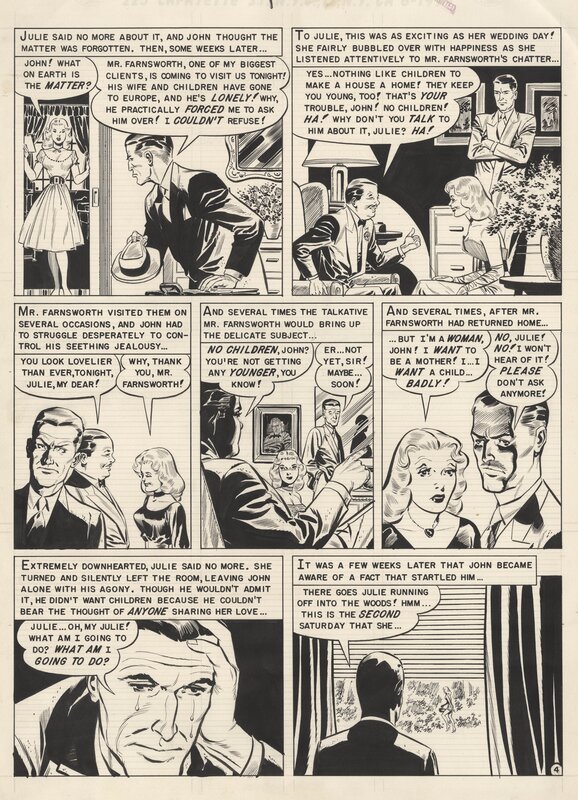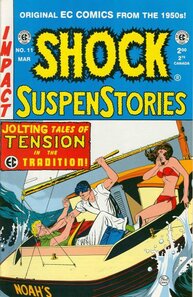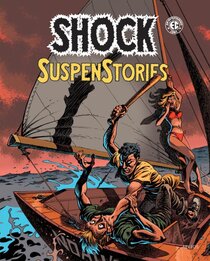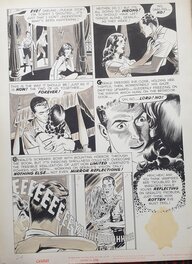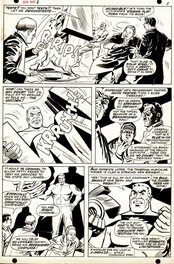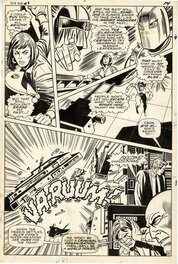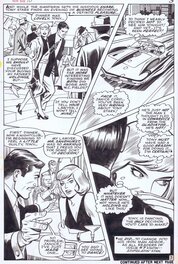In FanDePlanches 's collection
Shock Suspenstories - The Tryst - T11 p4
Ink
38 x 56 cm (14.96 x 22.05 in.)
Added on 3/11/23
Link copied to clipboard!
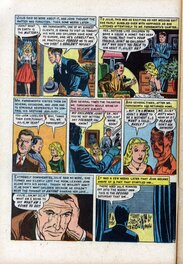
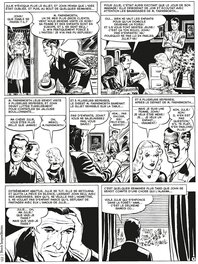
Description
Johnny Craig était un élément essentiel d'EC Comics au début des années 1950 et a contribué à ce que la ligne soit considérée comme le meilleur des éditeurs de genre Pre-Code. Le style typique, précis de Craig était idéal pour les contes policiers populaires d'EC. Cette page provient d'une histoire intitulée "The Tryst" publiée dans Shock SuspenStories #11 (1953). C'est l'histoire d'un homme jaloux de sa femme qui assassine une orpheline qu'elle veut adopter. Des contes assez horribles et probablement une histoire qui aurait été censurée après la création du code de la bande dessinée, qui a mis fin aux lignes d'horreur pré-codées d'EC.
Note: The top right corner has a 5" bend and a 1/2" cut on the right margin
Note: The top right corner has a 5" bend and a 1/2" cut on the right margin
Comment
1953, From "The Tryst!". Un homme est jaloux de sa femme et assassine l' orphelin qu'elle souhaite adopter.
Magnifique planche de Johnny Craig, format Twice-up. Son encrage est toujours sublime, et je souhaitais depuis longtemps faire entrer une planche de la magistrale et historique maison d'edition EC Comics.
Au cours des trois premières années, Shock SuspenStories a abordé de nombreuses questions controversées, notamment le racisme ("The Guilty" dans le n°3, "In Gratitude" dans le n°11), l'hystérie de la foule ("Les Patriotes" dans le n°2), la corruption policière ("Confession" dans le n°4), le vigilantisme ("Under Cover" dans le n°6), la toxicomanie ("The Monkey" dans le n°12) et le viol ("The Assault" dans le n°8, "A Kind of Justice" dans le n°16). Le format d'échantillonnage est resté pour les trois histoires restantes du titre jusqu'à la fin de 1953. Avec le numéro 12, les histoires d'horreur et de science-fiction ont été progressivement supprimées, et la bande dessinée s'est ensuite concentrée principalement sur les histoires de choc et de crime pour le reste de sa diffusion.
Magnifique planche de Johnny Craig, format Twice-up. Son encrage est toujours sublime, et je souhaitais depuis longtemps faire entrer une planche de la magistrale et historique maison d'edition EC Comics.
Au cours des trois premières années, Shock SuspenStories a abordé de nombreuses questions controversées, notamment le racisme ("The Guilty" dans le n°3, "In Gratitude" dans le n°11), l'hystérie de la foule ("Les Patriotes" dans le n°2), la corruption policière ("Confession" dans le n°4), le vigilantisme ("Under Cover" dans le n°6), la toxicomanie ("The Monkey" dans le n°12) et le viol ("The Assault" dans le n°8, "A Kind of Justice" dans le n°16). Le format d'échantillonnage est resté pour les trois histoires restantes du titre jusqu'à la fin de 1953. Avec le numéro 12, les histoires d'horreur et de science-fiction ont été progressivement supprimées, et la bande dessinée s'est ensuite concentrée principalement sur les histoires de choc et de crime pour le reste de sa diffusion.
1 comment
To leave a comment on that piece, please log in
About Johnny Craig
John Thomas Alexis Craig better known as Johnny Craig, was an American comic book artist notable for his work with the EC Comics line of the 1950s. He sometimes used the pseudonyms Jay Taycee and F. C. Aljohn.
Early life and career
Born in Pleasantville, New York, Craig studied at the Art Students League of New York. While attending classes, he began working in 1940 as an assistant of Harry Lampert, co-creator of All-American Comics' Golden Age superhero the Flash. The following year, after Lampert was drafted to serve to World War II, All-American editor Sheldon Mayer kept Craig on as an art department assistant, giving him progressively more responsible art duties. Between 1943 and 1945, Craig served in the Merchant Marines and the U.S. Army.
EC Comics
Returning to comics after his discharge, he began drawing for EC Comics, beginning with the penciling and inking the cover of Moon Girl and the Prince #1 (cover-dated Fall 1947). He did additional work on the following issue of that science fiction / superhero series, now titled simply Moon Girl, and went on to draw stories for the EC Western comics Saddle Justice and Gunfighter and the crime comic Crime Patrol..

